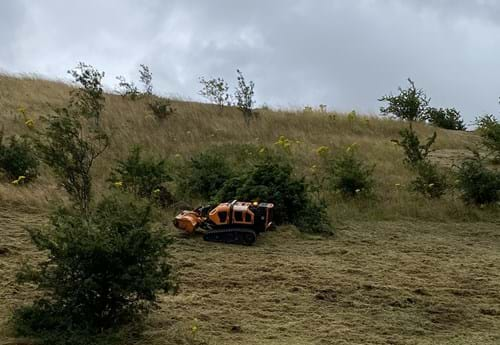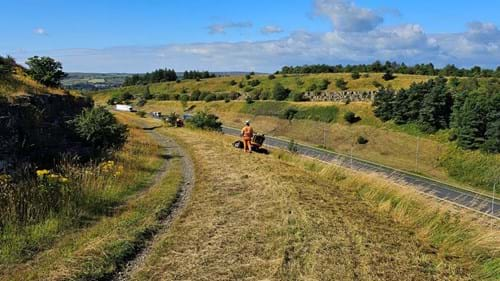Return of the flower power robots

Robots are revisiting Lancashire roadsides to help wildflowers to thrive a year after they were planted in a partnership to support wildlife and biodiversity.
Robots are revisiting Lancashire roadsides to help wildflowers to thrive a year after they were planted in a partnership to support wildlife and biodiversity.
After joining forces to create flower meadows along the M65 and A56 last year, National Highways and The Wildlife Trust for Lancashire, Manchester and North Merseyside have returned to the site with the specialist remote control equipment, or robot cutters.

A robot cutter in action
Using attachments such as a grass cutter and a rake, they’re cutting old wildflowers that have flowered and dropped their seeds for the new growth next year, and removing the cuttings from the meadow. National Highways Project Manager Betty Wilson explained this work will play an important role in ensuring the meadows thrive for years to come.
She said: “Wildflowers need a really nutrient-poor soil to thrive, which always seems surprising but if we leave the grass cuttings on site, the nutrients leech into the soil and promote the grass to grow and out-compete the wildflowers.
“It’s also important that the cutting is done outside of the main growing season for wildflower (May-July) as we need to give the wildflower a chance to grow and drop seeds ready for next year.”
The meadows have been funded using £1m from National Highways’ Designated Funds scheme.
Betty said:
“In 2022, we carried out baseline habitat surveys to identify what grasses and wildflower were already growing in the area and to see if it was suitable to improve into a wildflower meadow.
“Having found the area was suitable for wildflower growth, we created a scheme with our designer Amey to identify where we could and couldn’t plant within the plots, any risks and tasks on site and suitable wildflower seed mixes to use on road verges.
“We started with 24.8 hectares of poor condition grassland. By sowing wildflower seeds and maintaining the sites, we aimed to improve the grassland habitat to good condition.”
 Getting to work
Getting to work
Between August and November last year, teams involved in the project planted 24.8 hectares of wildflowers, with the Trust planting an additional 65 hectares of wildflower meadow in the area.
Since then, an amazing array of wildflowers has been identified at the spot near Accrington, including yellow rattle, cuckoo flower, bugle, cowslip and tiny vetch.
Betty said:
“Wildflower meadows capture and store carbon, like woodlands, which helps fight climate change. They also provide an important breeding ground for invertebrates such as insects and a key food source for many birds, amphibians and reptiles. The meadows also provide food and a habitat for small mammals such as voles, hedgehogs and rabbits.
“Established wildflower meadows have complex root systems, which make the soil very stable. This can help mitigate flooding by holding onto rainwater rather than it washing away.”
As well as using specialist tools to speed up the work, the robot cutters are keeping contractors safe by allowing them to stand in a suitable and safe location on the verge while they get to work.
Betty added: “We’re currently on the first year of establishment, so some of the wildflower species take up to two years to flower from seed, but then continue for years to come like ox-eye daises, red champion and knapweed.”
 A section of the wildflower meadow in Lancashire
A section of the wildflower meadow in Lancashire
Botany surveys will be carried out to check on what is growing at the site.
David Dunlop, Senior Conservation Officer for Policy and Advocacy at The Wildlife Trust for Lancashire, Manchester & North Merseyside, said:
“Road, rail, and energy networks already crisscross much of northwest England and nature recovery networks are now being identified in Local Nature Recovery Strategies in the Lancashire, Greater Manchester and Liverpool City Region.
“Here’s an example of how, by working together, existing “grey / hard infrastructure” may be retrofitted to create extensive new green infrastructure, which will begin to reverse damage done in the past and start to reconnect nature across our region.
"Land owned by transport operators, energy generators and energy extractors - as well as land directly proximal - will create "networks for nature", combining and connecting existing land of high ecological value with land that has the potential for restoration and long-term, biodiversity-focused management.”
National Highways Designated Funds
At National Highways, our work goes beyond operating, maintaining and improving roads.
As custodian of the country’s motorways and major A-roads, we know that the work we do makes a positive difference – for people, the economy and the planet.
The four Designated Fund plans are Safety and Congestion; Environment and Wellbeing; Users and Communities and Innovation and Modernisation.
Find out more at https://nationalhighways.co.uk/our-work/designated-funds/
Notes to Editors
National Highways is the wholly government-owned company responsible for modernising, maintaining and operating England’s motorways and major A roads.
Real-time traffic information for England’s motorways and major A roads is available via the Traffic England website, local and national radio travel bulletins, electronic road signs and mobile apps. Local Twitter services are also available.
For further information please contact National Highways' press office (24hrs) on 0844 693 1448 and select the most appropriate option:
Option 1: National enquiries (9am to 5.30pm) and out of hours for urgent enquiriesOption 2: North West (9am to 5.30pm)Option 3: Yorkshire and North East (9am to 5.30pm)Option 4: West Midlands (9am to 5.30pm)Option 5: East Midlands (9am to 5.30pm)Option 6: East (9am to 5.30pm)Option 7: South East (9am to 5.30pm)Option 8: South West (9am to 5.30pm)
